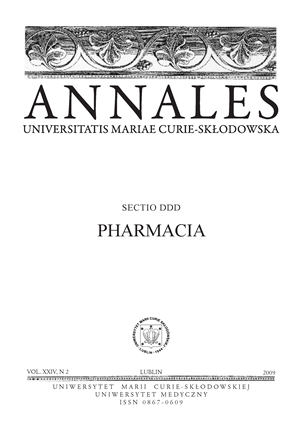Amikacin-modified hybrid biomaterial antimicrobial properties
DOI:
https://doi.org/10.2478/v10080-008-0176-9Abstract
Orthopaedic implant infections are a serious problem in present-day medicine. This study is a trial of a new type biomaterial with antimicrobial properties formed by chemical antibiotic immobilization on HAp granules surface. Biomaterial was protected from bacterial adhesion (Staphylococcus aureus ATCC 25923, Staphylococcus aureus MR3, Staphylococcus epidermidis ATCC 12228, Pseudomonas aeruginosa ATCC 27853) and biofilm formation. Biomaterial hybrid showed prolonged antimicrobial activity (20–30 days). Biomaterial was resistant to sterilization process and saved its biological activity. Amikacin-modified HAp granules with regard to its properties could be a profitable biomaterial for future medical applications.
References
1. el Deep K., Holmes R.: Tissue response to facial contour augmentation with dense and porous hydroxyapatite in Rhesus Monkeys. J. Oral Maxillofac. Surg.,47,1282, 1989.
2. Duran L. W.: Preventing medical device related infections. Med. Device Technol., 11(16),14,2000.
3. Gaździk T.: Zakażenia w ortopedii. Wyd. Urban&Partner, Wrocław 2004.
4. Ginalska G., Uryniak A., Łobarzewski J., Osińska M.: Immobilization method of antibiotics contain primary amino groups on solid matrices covered by protein. Polish Patent no P-358934, 2008.
5. Ginalska G., Kowalczuk D., Osińska M.: Amikacin-loaded vascular prothesis as an effective drug carrier. Int. J. Pharmaceut., 339 (1-2), 39, 2007.
6. Klemm K.: Antibiotic bead chains. Clin. Orthop., 295, 63, 1993.
7. Niedźwiedzki T., Kuryszko J. J.: Biologia kości. PWN, 23, Warszawa 2007.
8. Padilla S., Real del R. P., Vallet-Regi M.: In vitro release of gentamicin from OHAp/PMMA samples. J. Control Release, 83 (3), 343, 2002.
9. Polesiński Z., Karaś J., Jaegermann Z.: Ceramiczne wszczepy antybakteryjne. Szkło i Ceramika, 54, 2, 2003.
10. Różalska B., Sadowska B., Więckowska M., Rudnicka W.: Wykrywanie biofilmu bakteryjnego na biomateriałach medycznych. Med. Dośw. Mikrobiol., 50, 115, 1988.
11. Qu J., Chehroudi B., Brunette D.: The use of micromachined surfaces to investigate the cell behavioural factors essential to osseointegration. Oral Diseas, 2, 102, 1996.
12. Sudo A., Hasegawa M., Fukuda A., Uchid a A.: Treatment of infected hip arthroplasty with antibiotic-impregnated calcium hydroxyapatite. J. Arthroplasty, 23(1), 145, 2008.
13. Weetall H. H.: Covalent coupling methods for inorganic support materials. Methods Enzymol., 44, 134, 1976.
14. Zalewska J., Ginalska G., BelcarzA., Brzana W. et al.: Optimization of amikacin binding process to modified hydroxyapatite. Engineering of Biomaterials, 10 (69-72), 96, 2007.
Downloads
Published
Issue
Section
License
Copyright (c) 2009 Authors

This work is licensed under a Creative Commons Attribution-NonCommercial-NoDerivatives 3.0 Unported License.


